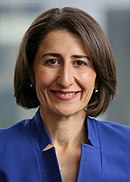| ||||||||||||||||||||||||||||||||||||||||||||||||||||||||||||||||||||||||||||||||||||||
All 93 seats in the Legislative Assembly and 21 (of the 42) seats in the Legislative Council 47 Assembly seats were needed for a majority | ||||||||||||||||||||||||||||||||||||||||||||||||||||||||||||||||||||||||||||||||||||||
|---|---|---|---|---|---|---|---|---|---|---|---|---|---|---|---|---|---|---|---|---|---|---|---|---|---|---|---|---|---|---|---|---|---|---|---|---|---|---|---|---|---|---|---|---|---|---|---|---|---|---|---|---|---|---|---|---|---|---|---|---|---|---|---|---|---|---|---|---|---|---|---|---|---|---|---|---|---|---|---|---|---|---|---|---|---|---|
| Opinion polls | ||||||||||||||||||||||||||||||||||||||||||||||||||||||||||||||||||||||||||||||||||||||
| ||||||||||||||||||||||||||||||||||||||||||||||||||||||||||||||||||||||||||||||||||||||
 Two-candidate-preferred margin by electorate | ||||||||||||||||||||||||||||||||||||||||||||||||||||||||||||||||||||||||||||||||||||||
| ||||||||||||||||||||||||||||||||||||||||||||||||||||||||||||||||||||||||||||||||||||||
The 2019 New South Wales state election was held on Saturday 23 March 2019 to elect the 57th Parliament of New South Wales, including all 93 seats in the Legislative Assembly and 21 of the 42 seats in the Legislative Council. The election was conducted by the New South Wales Electoral Commission (NSWEC).
The two-term incumbent Liberal/National Coalition Government led by Premier Gladys Berejiklian and Deputy Premier John Barilaro was re-elected to a third four-year term with a reduced majority in the Legislative Assembly, where government is formed. The main Opposition Labor Party under Michael Daley won an increased share of the vote in most districts, though the party was unable to successfully gain support in key marginal electorates. Minor parties the Greens and the Shooters, Fishers and Farmers Party, as well as several independent MPs, also contested the election.
ABC election analyst Antony Green called the election for the Coalition at about 8:15pm, over two hours after the 6:00pm close of polling booths.[1] However, it took a further two full days of official vote counting by the electoral commission before the ABC election computer was able to project that the Coalition had retained majority government.[2] Ultimately, the Coalition won 48 seats (35 Liberal, 13 National), suffering a loss of six seats from the 2015 election, providing the incumbent government with a slim two-seat majority. The Labor Party won 36 seats, an increase of two seats. Labor, and to a larger extent the Coalition, both suffered primary vote swings against them. Minor parties the Greens and the Shooters, Fishers and Farmers each won three seats, and they were joined on the crossbench by three independents.[3]
In the Legislative Council, 21 seats were up for election. The Coalition won eight seats, Labor seven, the Greens and One Nation each picked up two seats, whilst the Shooters, Fishers and Farmers Party and Animal Justice Party claimed one seat each.[4] One Nation's lead candidate Mark Latham, who led the Labor Party to defeat at the 2004 federal election, was elected to the Council.[4] In total the Coalition held 17 seats, Labor 14 and crossbenchers of other parties held 11.[4] The result left the Berejiklian Government needing at least five votes to pass legislation, up from the two they needed in the previous Council.[4]
It was the first time that the Coalition won a third consecutive term in office in New South Wales since the 1971 state election. Berejiklian became the first woman to lead a party to a state election victory in New South Wales, as well as the third woman to lead a party to a victory at a state election in Australia (after Queensland's Anna Bligh and Annastacia Palaszczuk) and the first non-Labor woman to do so.[5][6]
Daley had initially indicated that he would stay on as leader despite the loss. However, facing the prospect of a leadership spill, Daley announced several days after the election that he would stand down as leader and not contest a subsequent leadership election, to be held after the federal election in May. Deputy leader Penny Sharpe served as interim leader of the party in the intervening period.[7] That leadership election was subsequently held, and Strathfield MP Jodi McKay was elected as Labor Party Leader, against Kogarah MP Chris Minns.
New South Wales has compulsory voting, with optional preferential voting in single-member seats for the lower house and single transferable vote with optional preferential above-the-line voting in the proportionally represented upper house.
- ^ "NSW election delivers wins for Shooters, Fishers and Farmers, while Greens retain seats". ABC News. 23 March 2019. Archived from the original on 28 March 2019. Retrieved 28 March 2019.
- ^ "NSW election result confirmed, Gladys Berejiklian's Coalition wins 47th seat". ABC News. 25 March 2019. Archived from the original on 28 March 2019. Retrieved 28 March 2019.
- ^ "Results: NSW Election 2019". ABC Elections. Archived from the original on 24 March 2019. Retrieved 23 March 2019.
- ^ a b c d "One Nation wins two upper house seats in the NSW Parliament". The Sydney Morning Herald. 15 April 2019. Archived from the original on 15 April 2019. Retrieved 15 April 2019.
- ^ "Gladys Berejiklian praised as she becomes NSW's first elected female premier". The Sydney Morning Herald. 24 March 2019. Archived from the original on 24 March 2019. Retrieved 24 March 2019.
- ^ "Gladys Berejiklian rules out alliances with independents and minor parties". ABC News (Australia). 24 March 2019. Archived from the original on 25 March 2019. Retrieved 24 March 2019.
- ^ "Michael Daley won't contest NSW Labor leadership after losing election". The Guardian. 26 March 2019. Archived from the original on 26 March 2019. Retrieved 26 March 2019.


